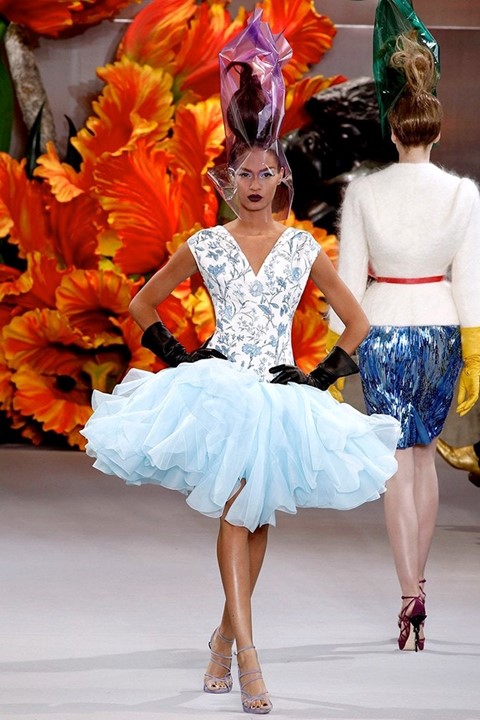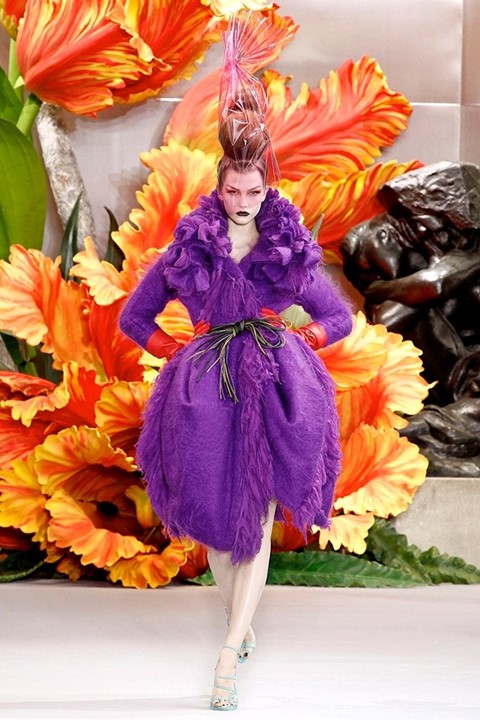Nearly a decade ago, John Galliano presented his Autumn/Winter 2010 haute couture show for Christian Dior, which brought a blossoming technicolour garden to life
The fashion shows that usually would have taken place in June and July this year – Men’s Spring/Summer 2021 and Haute Couture Autumn/Winter 2020-2021 – have been put on hold in the wake of the coronavirus pandemic. While we try to make sense of the enormity of this crisis in and outside of the fashion and culture industries, taking action when and where we can, there is little else to do but wait inside our homes.
Nearly ten years ago in June, John Galliano presented his penultimate haute couture collection at the house of Christian Dior for Autumn/Winter 2010. An unashamed celebration of florals in all their splendour, Galliano captured the essence of a blossoming technicolour garden, bringing it inside the Parisian building where the show was held. As there will be no upcoming haute couture collections – and we could all do with a little botanical escapism at present – we felt it a fitting moment to look back.
The Show
Christian Dior was notoriously green-fingered, a trait that he inherited from his mother Madeleine, watching her in the gardens at his childhood home Les Rhumbs, in Granville, northern France. During his lifetime as a couturier, M. Dior incorporated this passion for flowers into his work, basing the New Look on the shape of unfurling petals. “I designed clothes for flower-like women,” he said of his designs, “with rounded shoulders, full feminine busts and handspan waists above enormous spreading skirts.”
Backstage after the 2010 Autumn/Winter Haute Couture show, John Gallano spoke of Dior’s influence on the collection. “I’ve often said that I am here to tend the blooms that he already planted,” noted the designer. Although Dior kept and tended to many gardens over the years, for John Galliano it was the sprawling edens at La Colle Noire, Dior’s beloved residence at Grasse, that became the show’s inspiration, alongside a silhouette that he launched in 1953. Named the Tulip Line, it focused on cut-out necklines and a cinched-in waist, which then ballooned outwards at the peplum before tapering into a stem-straight skirt. “It wasn’t fully exploited,” mused Galliano. “[It] started to really fire my imagination and look into formations of all types of flowers.”
In his research, alongside orchids, pansies, sweet peas and crocuses, Galliano became obsessive over the parrot flower, even spending over an hour at a time watching the petals under light as it changed colour. It was a saffron-hued parrot flower that set the stage, forming a surreal backdrop to the catwalk – an oversized sculpture that could have been picked straight from the pages of Alice Through the Looking Glass. The wealth of colour and texture that followed in the clothes mimicked the cacophony of a floral garden. Mohair, organza, felt, taffeta and tulle was ruched and ruffled in a mouth watering palette, with waists nipped in by what appeared to be gardening twine (but was, in fact, fine strands of leather). Equally delicate pieces of suede in aquamarine and azure snaked round the feet like tendrils and vines. Galliano cleverly used black as a palette cleanser only; there was no room for the sombre in this collection.
The People
The casting was a ‘who is who’ of 00s faces: Karlie Kloss opened, wearing a blanket-like purple mohair coat, and was soon followed out by the likes of Liu Wen, Jessica Stam, Frida Gustavsson and Joan Smalls. Galliano chose Magdalena Frąckowiak to close the show in a gargantuan gown of black organza and tulle, with dégradé fronds unfolding from the waist, like silk napkins dipped in red wine.
Galliano’s usual team of collaborators were on board in full force. Make-up came courtesy of Pat McGrath, with Club Kid-esque graphic eyeliner stencilled over lids, and moody, plum lips set against the electric colours of the collection. Hair was shaped into towering bulbs by Orlando Pita, as though the models were growing clothes from the head down. The millinery – pieces of plastic in various shades designed to emulate florist’s cellophane – were dreamt up by Stephen Jones, and a pulsating soundtrack by Jeremy Healy included the string section from a Dutch house track interspersed with vocals from Robyn’s Hang With Me. As a subtle tribute, Galliano also incorporated floral prints by Irving Penn and Nick Knight – two photographers known for their love of all things botanical – into dresses.

The Impact
Since Galliano left the house in 2011, just a few seasons after he presented this show, the tending of M. Dior’s ‘blooms’ was famously handed over to Raf Simons. The Belgian designer marked his debut at the house in 2012 with a set made up of one million white orchids, yellow mimosa and blue delphiniums. More recently, Maria Grazia Chiuri cited the founder of the house’s sister Catherine for her S/S20 collection; Catherine Dior had survived the Ravensbrück concentration camp to go on and sell flowers at Paris’ Les Halles market after the war, which speaks of the flower as a symbol of hope. If ever there was a time we needed another, it’s now.
